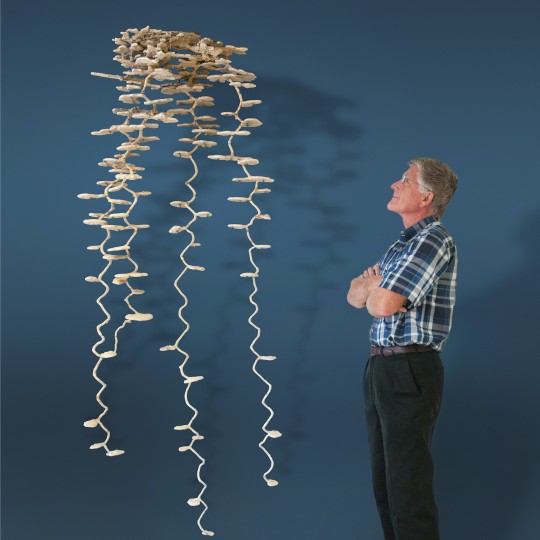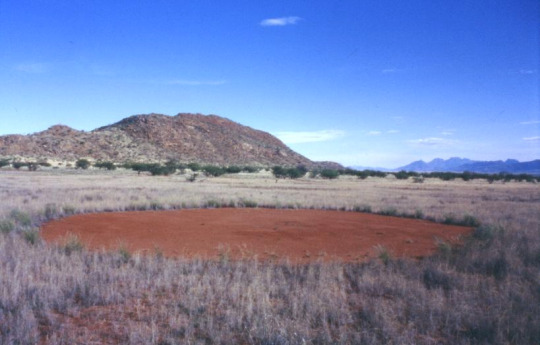#Walter Tschinkel
Text

Somehow, in all my years of being a bug nerd, I never came across Dr. Walter Tschinkel's amazing ant nest casts. Look at this Florida harvester ant nest! It's huge! With spiral staircases!
#I love it#true DIY creativity#curiosity is a beautiful thing#Walter Tschinkel#ants#bugblr#entomology
803 notes
·
View notes
Text


Fairy circles are circular patches of land barren of plants, varying between 2 and 12 metres (7 and 39 ft) in diameter, often encircled by a ring of stimulated growth of grass. They occur in the arid grasslands of the Namib desert in western parts of Southern Africa, and in a part of the Pilbara in Western Australia. Studies have posited various hypotheses about their origins, but none have conclusively proven how they are formed. Theories include the activities of various types of termites, or the consequence of vegetation patterns that arise naturally from competition between grasses.
In 2012, Eugene Moll suggested the termite species Baucaliotermes hainsei and Psammotermes allocerus as the creator of these circles. All rings have been found to contain termite casts, and radar investigations suggest that a moist layer of soil is situated beneath the fairy circles.[10]
In 2013, this theory was supported by Norbert Juergens. Juergens found evidence that the sand termite, Psammotermes allocerus, generates a local ecosystem that profits from and promotes the creation of the fairy circle.[14][15] The sand termite was found in 80-100% of the circles, in 100% of newly formed circles,[14] and was the only insect to live across the range of the phenomenon. Sand termites create the fairy circle by consuming vegetation and burrowing in the soil to create the ring. The barren circle allows water to percolate down through sandy soil and accumulate underground, allowing the soil to remain moist even under the driest conditions. Grass growth around the circle is promoted by the accumulated soil water, and in turn the termites feed on the grasses, slowly increasing the diameter of the circle. This behaviour on the part of Psammotermes allocerus amounts to creation of a local ecosystem in a manner analogous to behaviour of the common beaver.[4]
Walter R. Tschinkel, a biologist at Florida State University, who also researched the fairy circles, remarked that Juergens, "has made the common scientific error of confusing correlation (even very strong correlation) with causation".[15] Previously, Tschinkel had searched for harvester termites without success.[15][16] Juergens responded that sand termites differ from harvester termites and live deep beneath the circle; they do not create mounds or nests above ground, and they leave no tracks in the sand.[15] In such respects the sand termite is unusually inconspicuous in its activities.
Later in 2013, Michael Cramer and Nichole Barger suggested that the circles were the consequence of vegetation patterns that arose naturally from competition between grasses.[17] They examined the conditions under which fairy circles arise and found that fairy circles are negatively correlated with precipitation and soil nutrition. This observation is consistent with resource competition being a cause of the crop circles. Grassy landscapes with a mixture of grasses can result in barren spots as a consequence of under-ground competition between different types of grasses. The patches are maintained because they form a reservoir of nutrients for the taller grasses at the periphery and possibly because of the activity of termites, as in the theory above. Using rainfall, biomass and temperature seasonality, they can predict with high accuracy the presence or absence of fairy circles in a region. According to Walter Tschinkel, this theory accounts for all the characteristics of fairy circles, including the presence of tall grass species.[18] Other recent work has considered interacting combinations of both animal- and vegetation-induced patterning effects as a potential unifying theoretical explanation for the fairy circle phenomenon.[19]
A 2015 theory about the Australian fairy circles suggested that the distinct vegetation patterns are a population-level consequence of competition for scarce water, as the plants "organise" themselves to maximise access to scarce resources. The circular barren patches capture water which then flows to the outer edges of the ring. More water available increases biomass and roots which leads to the soil becoming looser. The less dense soil allows more water to penetrate and feed the vegetation, creating a feedback loop supporting the plants at the edge of the circle.[20] Field observations by Sujith Ravi, Lixin Wang and colleagues using soil moisture, soil particle size, and soil water infiltration measurements in Namibia in 2015 and 2016 support this.[21]
In 2021 an explanation using hydrological feedbacks and the Turing mechanism was proposed as the cause of the patterns in Australia.[22][13]
In February 2023, weak seeps of hydrogen through faults, fractures, and diffused through rocks, were identified as a possible cause of the depressions. One researcher suggested that "hydrogen-loving microbes" may consume all other nutrients in the soil.[23]
15 notes
·
View notes
Text
Movement Brainstorming Ideas: Insects

The movement of bugs is very strange and alien and I would be interested in looking into it more. The scuttling, scurrying and fluttering.
I love photographing bugs and I have a large collection to work off now, here are a few: (primary research)




I came across Walter Tschinkel's aluminum casts of ant colonies as I was researching. He is an entomologist who pours molten aluminum down the holes of ant colonies to reveal the architecture within.

He then excavates the site to dig up these strange, organic, chandelier-like structures. I don't know if I agree with the ethics of his work, its extremely destructive. However, I still find the results very interesting and beautiful. It's a hidden world that we usually don't get to see. The movement of insect cities down through the earth.

Walter Tschinkel has pulblishes a book- 'Ant Architecture: The Wonder, Beauty, and Science of Underground Nests' in 2021.
8 notes
·
View notes
Photo

#Walter R. Tschinkel#ants#entomology#nature#Tschinkel#Walter Tschinkel#science#nests#book cover#cover design#biology#ant architecture#architecture
206 notes
·
View notes
Photo

Ant nest cast by Walter Tschinkel
https://science.thewire.in/environment/fire-ant-nest-underground-architecture-walter-tschinkel/
https://press.princeton.edu/books/hardcover/9780691179315/ant-architecture
12 notes
·
View notes
Text
Totally Random Non-Fiction Tuesday

Oof. I was iffy about reading this book. Flies are not my favorite insect, although they do rank above mosquitos. Balcombe almost, almost, convinced me though. Explaining the order Diptera (flies) and how much they help the world. (Including how they help there be cacao. Which, yep, chocolate is very important!).
Some of it I sort of winced through. Or ‘ew ew ew ew’d’ through, but, on the whole, it was an interesting book about an animal that, while I still don’t like it, I do see how important they are.
You may like this book If you Liked: The Hidden Life of Trees by Peter Wohlleben, Ant Architecture by Walter R. Tschinkel, or Not So Different by Nathan H. Lents
Super Fly: The Unexpected Lives of the World's Most Successful Insects by Jonathan Balcombe
#totallyrandomnonfictuesday#nmlRA#nevins memorial library#super fly#jonathan balcombe#super fly the unexpected lives of the world's most successful insects
0 notes
Video
youtube
Liked on YouTube: Mating frenzies, sperm hoards, and brood raids: the life of a fire ant queen - Walter R. Tschinkel https://youtu.be/RNdouBNrnM0
0 notes
Text
Mating frenzies, sperm hoards, and brood raids: the life of a fire ant queen - Walter R. Tschinkel https://t.co/NeS0EQ8140
Mating frenzies, sperm hoards, and brood raids: the life of a fire ant queen - Walter R. Tschinkel https://t.co/NeS0EQ8140
— Bee Academic Tutors (@BeeAcademic) January 16, 2020
from Twitter https://twitter.com/BeeAcademic
0 notes
Quote
There's actually more art in science than most people suspect.
Walter Tschinkel
5 notes
·
View notes
Photo


Walter Tschinkel's Aluminum Casts of Ant Colonies Reveals Insect Architecture
This is pretty freaking amazing, and gives new meaning to the term "sacrifical casting." Retiree Walter R. Tschinkel is an entomologist and former professor of Biological Science at Florida State University. He recognizes ants as "some of nature's grand architects" and, curious to understand their self-created habitats, devised a clever (if cruel) way to do it: By pouring molten aluminum down into the hole.
60 notes
·
View notes